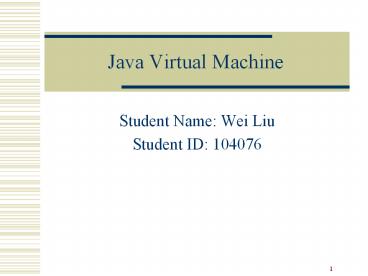Java%20Virtual%20Machine - PowerPoint PPT Presentation
Title:
Java%20Virtual%20Machine
Description:
It help Java create high level of portability by hiding the difference between ... Java's goal is 'Write-Once-Run-Anywhere'. Java programs are not computer, ... – PowerPoint PPT presentation
Number of Views:1488
Avg rating:3.0/5.0
Title: Java%20Virtual%20Machine
1
Java Virtual Machine
- Student Name Wei Liu
- Student ID 104076
2
Java Virtual Machine
- JVM is part of Java programming language.
- JVM is a software, staying on top of Operating
System, such as UNIX, Windows NT. - It help Java create high level of portability by
hiding the difference between the Operating
System implementations. - It creates an environment that Java language
lives.
3
Why JVM?
- An ordinary language can not create a system
independent program. - Javas goal is Write-Once-Run-Anywhere. Java
programs are not computer, operating system
dependent. - Need to create an abstract computer of its own
and runs on it, a kind of virtual machine which
hiding the different OS implementations.
4
Java Runtime Environment.
5
How JVM works?
- Java programs are compiled into byte code.
- JVM interprets and converts Java byte code into
machine code in order to execute on a CPU. - Most web browser has an integrated JVM to run
applets.
6
How JVM works?
- Other JVM tasks include
- Object creations of Java programs.
- Garbage collection.
- Security responsibility.
7
JVM Fundamental Parts.
- A byte code instruction set
- A set of registers
- A stack
- A garbage-collected heap
- An area for storing methods
- All five parts are necessary, may be implemented
by a compiler, an interpreter or a hardware chip.
8
Byte Code Instruction Set
- JVM keeps a compact set of Byte Code Instructions
in order to interpret byte code into native
binary code. - Java compilers do not translate programs directly
into native binary code, which is system
dependent. Instead, programs are translated into
byte code, just in its mid-way to a runnable. - JVM interprets these half-cooked byte code into
executable machine code on different computer
systems and platforms.
9
Registers.
- The registers of the Java virtual machine are
just like the registers inside a real computer.
(32 bit wide) - PC program counter
- OPTOP Pointer to operation stack.
- FRAME Pointer to execution environment of
current method. - VARS Pointer to the first local variable of
current method.
10
Stacks
- JVM is stack based.
- The stack is used to supply parameters to byte
codes and methods, and to receive results back
from them. - Each stack frame contains three (possibly empty)
sets of data the local variables for the method
call, its execution environment, and its operand
stack.
11
Heaps.
- The heap is that part of memory from which newly
created instances (objects) are allocated. - The heap is often assigned a large, fixed size
when the Java run-time system is started, but on
systems that support virtual memory, it can grow
as needed, in a nearly unbounded fashion. - Objects in heap are automatically
garbage-collected when they are not needed.
12
The Method Area.
- The method area stores the Java byte codes that
implement almost every method in the Java system. - The method area also stores the symbol tables
needed for dynamic linking, and any other
additional information debuggers or development
environments might want to associate with each
methods implementation.
13
Drawbacks of JVM.
- JVM is a layer on the top of your operating
system that consumes additional memory. - JVM is additional layer between compiler and
machine. (Comparing Java program and fast C
program!) - Byte code is compiled for system independence so
it does not take advantage of any particular
operating system.
14
JIT Compiler.
- JIT stands for Just In Time.
- 10 years ago, a smart idea was discovered by
Peter Deutsch while trying to make Smalltalk run
faster. He called it dynamic translation during
interpretation. - Every time JIT compiler interprets byte codes, it
will keep the binary code in log and optimize it.
Next time, when the same method is running, the
optimized code will run. Experiments show Java
programs using JIT could be as fast as a compiled
C program.
15
JIT Example.
- ( Loop with 1000 times )
- for(int i0ilt1000i)
- do_action( )
- Without JIT, JVM will interpret do_action()
method 1000 times. (A waste of time!) - With JIT, JVM interprets do_action() method
only once and keeps it in log, and the binary
native code will execute for the rest 999 loops.
16
JIT Compiler.
Java Compiler
Java Virtual Machine
- Compiled
- Byte Code
JIT Compiler
Optimized Kept in Log
Native Machine Code
Machine
17
JVM Security Capability.
- JVM has many capabilities to keep the security of
the computer system. - Sandbox prohibit a Java applet
- Reading or writing to the local disk
- Making a network connection to any host, except
the host from which the applet came - Creating a new process
- Loading a new dynamic library and directly
calling a native method
18
Security Holes of JVM
- Netscape 4.X consists of JVM that has flaws.
- A hostile applet could turn the client browser
into an http server that allows almost anyone in
the world to read/modify/delete files residing on
the client (turned server) machine. - Ways to deal with malicious applets.
19
Current JVM.
- Microsoft Java Virtual Machine.
- Netscape Java Virtual Machine.
- Sun Java Virtual Machine.
- All these Java Virtual Machines implement Java
core class packages and their own specific class
packages.
20
References.
- http//java.sun.com
- http//www.cs.princeton.edu
- http//www.research.IBM.com
- http//www.javaworld.com
- http//www.sans.org
- http//www.javacoffeebreak.com
- http//www.computerworld.com
- http//www.zdnet.com
21
Questions?































